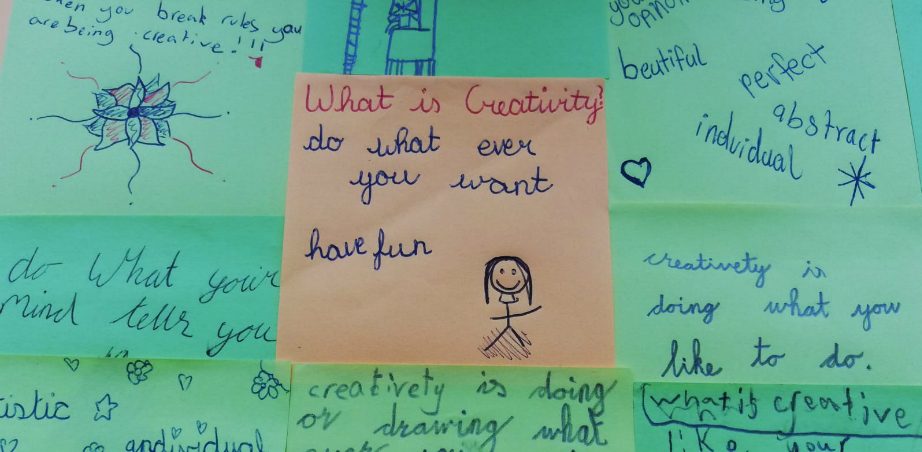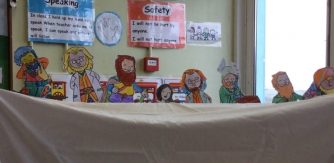Blog 2 – Naomi Cahill Creative Associate for Creative Schools & Director of Bespoke Productions

What is Creativity-Colour Version

Naomi Cahill works as a Creative Associate for Creative Schools and is founder and director of Bespoke Productions. She is an experienced and qualified drama teacher of primary, second level and adult education as well as children with special needs and adults with physical and intellectual disabilities. Naomi graduated with a degree in Drama & Theatre Studies from University College Cork. She further completed the Higher Diploma in Arts in Drama Education and was awarded‘Highest Academic Achievement’ from the Leinster School of Music & Drama. Through Bespoke Productions, Naomi leads drama courses in Ireland and abroad which are aimed at building confidence, self-esteem and developing communication skills. She most recently directed a modern version of ‘Romeo & Juliet’ at Teatro Re Grillo, Licata, Sicily. Having performed both on stage and in film, she enjoys sharing her experience with her students. She is delighted to be working as a Creative Associate for the Creative Schools programme.
Creative Schools: The Journey Continues – Blog 2
Creative Schools Coordinators:
In every Creative School there is a Creative Schools Coordinator. The coordinator is my first point of contact with each school and I liaise with them in regular meetings. I have now met all coordinators in my corresponding schools. In some schools the coordinator is a member of the teaching staff and in others it is the school principal. There has been a great response and enthusiasm from all coordinators and schools as a whole to the project and a strong belief in the positive impact it can make on putting the arts and creativity at the heart of young people’s lives.
Completion of Step One: ‘Understand’:
I am continuing to work with schools on the process of gaining an understanding of the school’sengagement with the arts and creativity. Having completed workshops and meetings with relevant parties and staff, I am liaising with Creative Schools Coordinators to complete the documentation for this section. All schools are provided with a document called ‘Understand’ complete with four sections: 1) Children & Young People 2) Teaching & Learning 3) Leadership & Management & 4) School Environment, Opportunities & Networks. In each section there are a series of statements which are rated on a scale of: 0-5 (0 means: the statement is ‘Not at all true’, 5 means: the statement is ‘Very true’). For example: “Pupils/students are involved in decision-making on existing arts opportunities and are able to shape their learning experiences in school” (Section 1: Children & Young People). Using age specific surveys designed for appropriate parties and information gathered from staff discussions I work with coordinators to rate all statements (using an average from the individual ratings). The following individuals are consulted with in this process: the school principal, deputy principal, coordinator, teachers (including resource staff & S.N.A.s), staff with a responsibility for the arts, parent’s association and board of management. These findings will support the development of the Creative Schools Plan which will be carried out in step two: ‘Develop’.
What is Creativity?
As I mentioned in my previous post the voice, opinions and views of young people is of key importance to this pilot project. Through ‘The Voice of Young People’ workshop I collected lots of useful information which I use as data for the ‘Children & Young People’ section and to influence my work with schools going forward. I go through this information, document and analyse it. I found it inspiring to read young people’s understanding of the word ‘Creativity’. From my experience, all young people have their own individual understanding of creativity. It is very interesting and uplifting read their definitions:
“I think it is about showing who you are and what you like to do”. “I think if you’re creative, you have a big imagination”.
“It’s about expressing yourself”.
“Imagination”.
“Like your dreams are what you feel & draw & do”.
“Do what your mind tells you”.
“Creativity is free! When you break rules, you are being creative”.
I believe it is important to let young people come up with their own understanding of creativity rather than provide them with a set definition. This is similar to the constructivist approach I often use in my own teaching. Using constructivism, students are actively involved in constructing their own meaning and knowledge as opposed to passively receiving information.
Through the workshop, I also gathered information on student’s individual artistic and creative interests. Students listed: the creative activities they are currently engaged with inside and outside school. They also listed the creative things they would like to do if they had the opportunity. It is very interesting to hear their responses. The answers vary greatly from school to school. The school’slocation and the cultural and artistic opportunities in close proximity of the school also have an influence on the responses given.
Meeting Teachers:
I have commenced meeting all teaching staff in my corresponding schools. It is very important that staff are fully aware of what is involved in Creative Schools and are able to contribute their ideas in order for the project to be of benefit. The staff are of key importance to ensure the sustainability and longevity of the project. In these meetings I initially provide staff with a thorough understanding of Creative Schools. I then explain the different components of the programme including the first step: ‘Understand’. I design posters listing the following questions as headings:
What are the creative strengths of the school?
What creative areas can the school develop?
What creative activities can the school implement to develop these areas?
I then facilitate a discussion with staff where they are given the opportunity to provide answers/ideas to questions listed. We pass around the posters and everyone makes a written note of their contributions. I also ask staff about their own individual areas of expertise for example: Is there a staff member that is a particularly skilled/trained musician/dancer? etc. This is very beneficial for all staff to be aware of going forward. I have found that a lot of schools are interested in working collaboratively together to share their creative skills and knowledge.
New Beginnings in 2019:
I am looking forward to a new year of opportunities for Creative Schools and excited to move on to the next stage of the project.


